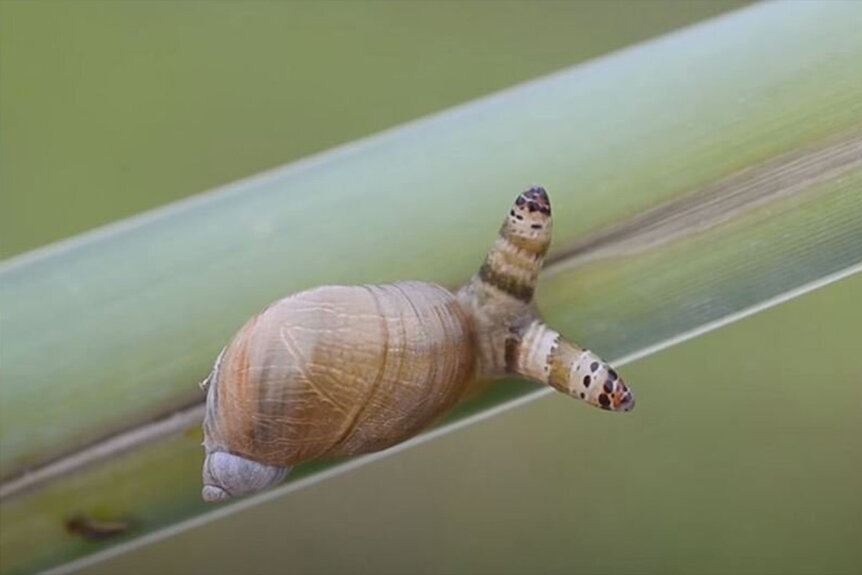Create a free profile to get unlimited access to exclusive videos, sweepstakes, and more!
Surviving the Sarlacc pit: The science behind 'The Book of Boba Fett'
Boba Fett might have missed out on the chance to metamorphose into his true form.

It's one of the seminal scenes in Return of the Jedi. Luke and the whole gang are fighting for their lives outside Jabba's floating barge, Leia is in chains, Lando is hanging on by a thread over the ravenous Sarlacc pit, and Boba Fett has entered the fight. Things are not going well for the heroes of our tale. Then, in a moment of serendipitous happenstance, Han damages Fett's jetpack and sends him careening off the barge and into the mouth of the Sarlacc. Thus was the ending for the most beloved bounty hunter in the galaxy — Or so we thought. Season 2 of The Mandalorian confirmed that Boba Fett actually survived his lethal encounter with the Sarlacc and in the first episode of The Book of Boba Fett, we found out how.
Fett succeeded where so many others failed through quick thinking, ingenuity, and the slow churning specifics of Sarlacc digestion. We're lucky not to have Sarlaccs on our planet, but we do have all sorts of predators which eat other plants and animals. And, not unlike Boba Fett, some real-life organisms have figured out how to survive being eaten and come out on the other side ready to star in their own spin-off TV series.
PLANTS THAT LIKE TO BE EATEN
Plants get eaten more than any other thing on our planet. They form the foundation of our food web, taking in energy from the Sun and nutrients from the soil to turn them into something which can be consumed by animals.
While crunching into a nice carrot, frying up some potatoes, or dressing up a salad might be a good time to the person doing the eating, it isn't much fun for the plants. According to a study carried out by the University of Missouri, plants know when they're being eaten and some of them try to make it stop. In the study, researchers exposed leafy plants to the sounds of caterpillars eating them and found that they released defense chemicals to try and end the attack. They may not have ears, but that apparently doesn't mean they can't hear themselves being eaten alive.
On the other end of the spectrum, some plants have evolved specifically to be eaten in order to reproduce. Fruiting plants place their seeds intentionally inside squishy and nutritious fruit in an attempt to attract the attention of animals.
When the fruit is ripe birds or other animals come calling. Once the fruit is eaten, the seeds find themselves in the stomach and digestive system of the animals, which might seem like a death sentence but is, in fact, quite the opposite.
Many seeds have evolved to have a protective layer which shields them from the violent environment inside an animal's body while they hitch a ride through the digestive system en route to parts unknown. Eventually the seeds are excreted, hopefully onto soil, and they're surrounded in nutrient-rich fertilizer to boot. Many of those seeds don't strictly need animals in order to reproduce, but it helps with getting around, especially when your parent is literally rooted to the spot.
Blackberries take this process a step further. Being eaten is a necessary step in their reproductive process. Blackberry seeds begin life dormant and must be abraded by the gizzards — a specialized part of the stomach for grinding food — in order for them to become active.
ANIMALS THAT LIKE TO BE EATEN
If you're an animal (you are, in case you were wondering) being eaten is usually a bad thing. Most of us spend our whole lives — whether through camouflage, complex defense mechanisms, or building civilizations — trying to avoid being eaten. Then there are parasites.
Some parasites do just fine on their own, hanging out in the environment and infecting plants and animals only as a matter of convenience. Others need to be eaten as a part of their ordinary life cycle.
One of the most flamboyant examples is a mind-controlling parasite that infects snails. Leucochloridium, also known as the Green-Banded Broodscac, live in the cloaca of birds. When the birds defecate, they carry the eggs of the parasite to the ground where they are eaten by unsuspecting snails. As if having to eat feces to survive wasn't bad enough, that's when things get truly terrifying.
Once the eggs have made their way into the snail's gut they emerge and spread. Eventually they can make up more than 20 percent of the snail's total weight. In order to complete the life cycle they need to get eaten again, this time by a bird.
Mature broodsacs accomplish this by infesting the snail's eyestalk, or tentacle, which causes the stalk to swell and pulsate. Moreover, they control the snail by making it hang out in more conspicuous places, so that it's more likely to be seen by a predator. To a bird's eye, the pulsating tentacles look like a delicious caterpillar waiting to be eaten.
It sounds like a pretty awful way to live and die if you're a snail, but it's all part of a normal life for the brood sac, moving from one animal's digestive system to another. All of that said, unless you're a fortified seed or a terrifying parasite, it's probably best to avoid being eaten if you can help it.
If you can't, then you better hope you have a solid right hook and a wrist-mounted flamethrower handy.




























